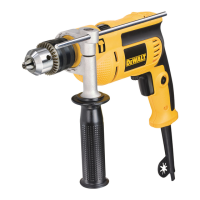9
ENGLISH
Trigger Switch (Fig. A)
To start the drill, depress the trigger switch; to stop the drill,
release the triggerswitch.
NOTE: Use lower speeds for starting holes without a
center punch, drilling in metal or plastics, driving screws
or drilling ceramics. Higher speeds are better for drilling
wood and composition boards and using abrasive and
polishingaccessories.
Variable Speed
A variable speed trigger switch
1
permits speed control—the
farther the trigger is depressed, the higher the speed of thedrill.
For continuous operation, press and hold the variable speed
switch, move the lock‑on button
2
up, then release theswitch.
To stop continuous operation, press the switch briefly and
release it. Always switch the tool off when work is finished and
beforeunplugging.
Proper Hand Position (Fig. I)
WARNING: To reduce the risk of serious personal injury,
ALWAYS use proper hand position as shown.
WARNING: To reduce the risk of serious personal injury,
ALWAYS hold securely in anticipation of a suddenreaction.
Proper hand position requires one hand on the main
handle
10
, with the other hand on the side handle
7
to
control the twisting action of thedrill.
Drilling
WARNING: To reduce the risk of serious personal
injury, turn tool off and disconnect tool from power
source before making any adjustments or removing/
installing attachments or accessories. Be sure the
trigger switch is in the OFF position. An accidental start‑up
can causeinjury.
OPERATION
Instructions for Use
WARNING: Always observe the safety instructions and
applicableregulations.
WARNING: To reduce the risk of serious personal
injury, turn tool off and disconnect tool from power
source before making any adjustments or removing/
installing attachments or accessories. An accidental
start‑up can causeinjury.
Keyless Chuck Removal (Fig.G)
Tighten the chuck around the shorter end of a hex key (not
supplied) of 6 mm or greater size. Using a soft hammer or piece
of wood, strike the longer end in the counterclockwise direction.
This will loosen the chuck so that it can be unscrewed byhand.
Keyless Chuck Installation (Fig.H)
Screw the chuck on by hand as far as it will go. Tighten the
chuck around the shorter end of a 6 mm or larger hex key (not
supplied) strike the longer end in the clockwise direction with a
softhammer.
WARNING: To reduce the risk of personal injury,
ALWAYS ensure workpiece is anchored or clamped firmly.
If drilling thin material, use a wood “back‑up” block to
prevent damage to thematerial.
1. Use sharp drill bits only. For WOOD, use the low speed
setting and twist drill bits, spade bits, power auger bits, or
hole saws. For METAL, use the low speed setting and steel
twist drill bits or hole saws. For MASONRY, such as brick,
cement, cinder block, etc., use carbide‑tipped bits rated for
percussiondrilling.
2. Always apply pressure in a straight line with the bit. Use
enough pressure to keep drill biting, but do not push hard
enough to stall the motor or deflect thebit.
3. Hold tool firmly with both hands to control the twisting
action of thedrill.
CAUTION: Drill may stall if overloaded causing a sudden
twist. Always expect the stall. Grip the drill firmly to control
the twisting action and avoidinjury.
4. IF DRILL STALLS, it is usually because it is being overloaded
or improperly used. RELEASE TRIGGER IMMEDIATELY,
remove drill bit from work, and determine cause of stalling.
DO NOT CLICK TRIGGER ON AND OFF IN AN ATTEMPT
TO START A STALLED DRILL — THIS CAN DAMAGE
THEDRILL.
5. To minimize stalling or breaking through the material,
reduce pressure on drill and ease the bit through the last
fractional part of thehole.
6. Keep the motor running when pulling the bit back out of a
drilled hole. This will help preventjamming.
7. With variable speed drills there is no need to center punch
the point to be drilled. Use a slow speed to start the hole
and accelerate by squeezing the trigger harder when the
hole is deep enough to drill without the bit skippingout.
Drilling in Metal
Start drilling with slow speed and increase to full power while
applying firm pressure on the tool. A smooth even flow of metal
chips indicates the proper drilling rate. Use a cutting lubricant
when drilling metals. The exceptions are cast iron and brass
which should be drilleddry.
NOTE: Large [8 mm to 13 mm] holes in steel can be made
easier if a pilot hole [4 mm to 5 mm] is drilledfirst.
Drilling in Wood
Start drilling with slow speed and increase to full power while
applying firm pressure on the tool. Holes in wood can be
made with the same twist drills used for metal. These bits may
overheat unless pulled out frequently to clear chips from the
flutes. Work that is apt to splinter should be backed up with a
block ofwood.
Drilling in Masonry
When drilling in masonry, use carbide‑tipped bits rated for
percussion drilling and be certain that the bits are sharp. Use a
constant and firm force on the tool to drill most effectively. A
smooth, even flow of dust indicates the proper drillingrate.

